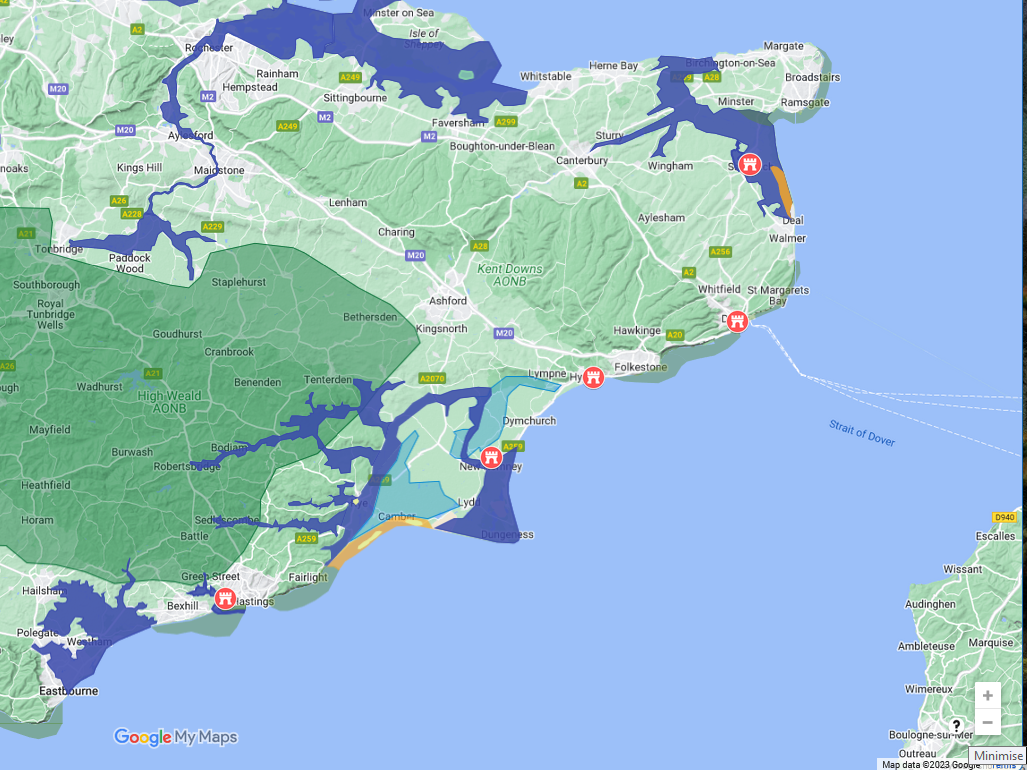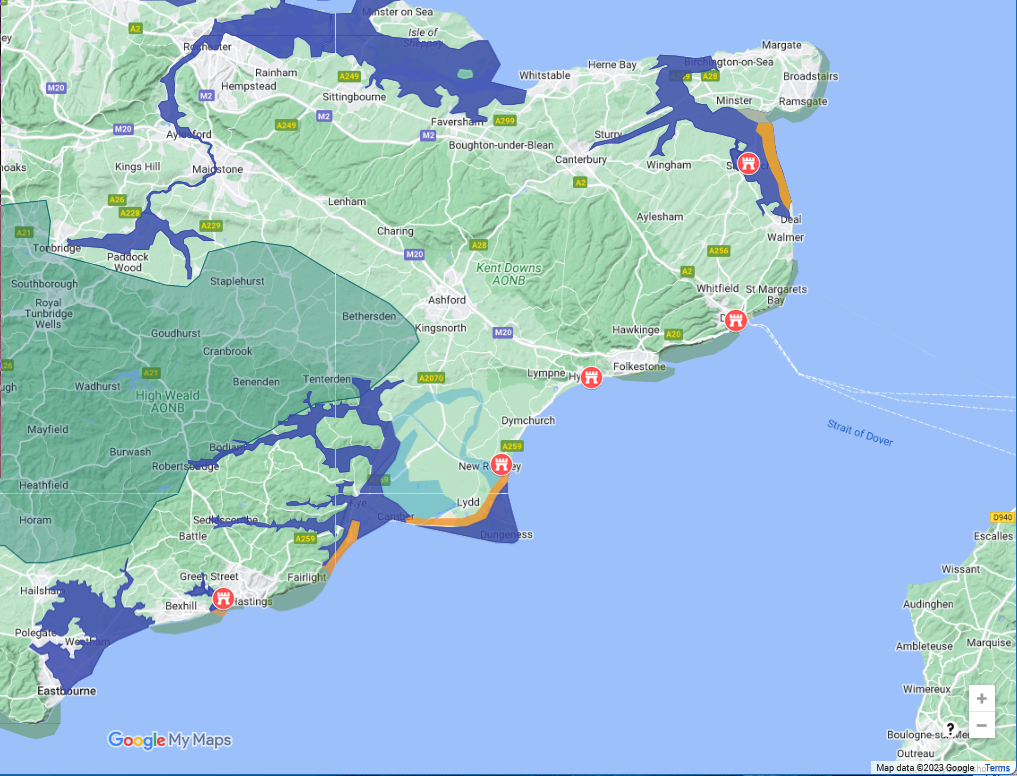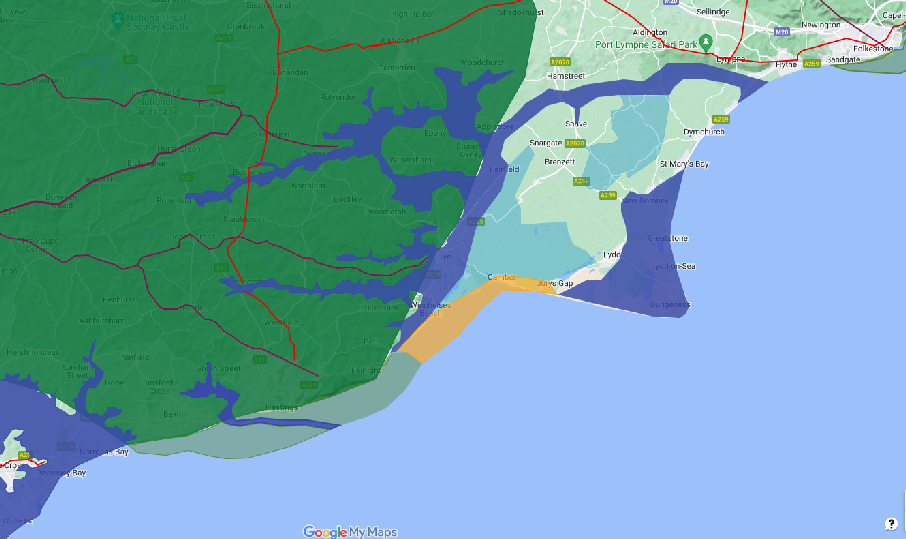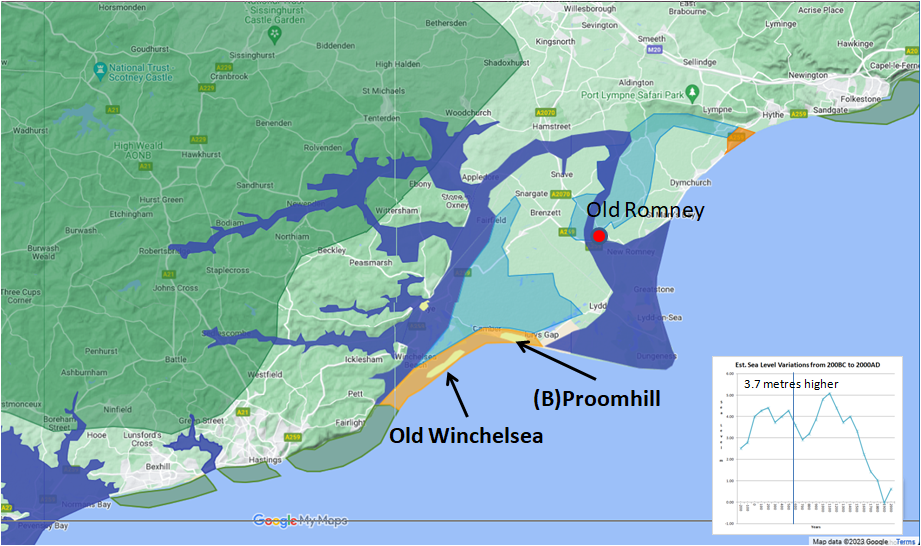|
 | Anglo Saxon History |  | |
| | Landscape - The 1287AD Storm and its effect on the Kent and Sussex Coast |
|---|
| |
|---|
The Great Storm of 1287AD
|
|---|
There was a major storm in the English Channel on 4th February 1287AD, which had a profound effect on the Kent and
Sussex coasts and on the Cinque Ports.
For details of the Cinque Ports see our (The Cinque Ports and Southern England) page.
For more on the Romney Marsh please see our (Landscape -
The History of the Romney Marsh in maps(Pre-Roman to Modern times)) page.
| | |
|---|
The landscape before the Great Storm ▲
|
|---|

Before the storm:
The landscape and coastline of East Sussex and Kent was significantly different especially relating to the area of the
Cinque Ports.
This map shows a representation of the area showing the high tide/high tide levels for the period, together with the
extended coastline now not visible due to erosion at about 0.8 metre/year at Hastings and a bit more on the chalk cliffs
at the 'Seven Sisters' at Beachy Head and the 'White Cliffs' at Dover.
The port of Hastings was in the current Filsham valley in a protected inlet and probably had shipyards producing vessels
from the adjacent Forest of Andredsweald.
(The Great Forest of Andredsweald -
Anglo Saxon Chronicles)
New Romney was a really important port, as shipyards up the river Rother near Appledore and Newenden provided the port
with a very large number of ships, and Langport (the long port) was located at the river entrance.
Hythe was less important than New Romney, however its ships were most likely provided by the shipyards behind New
Romney.
The port of Dover was protected more than at present as the cliff protected the port at the time, and this port was the
least effected by the storm.
Finally the port of Sandwich was protected by a shingle bank projecting up from the Deal and Walmer area.
| | |
|---|
The landscape after the Great Storm ▲
|
|---|

After the storm:
The entrance to the port of Hastings was blocked by shingle from the Cliffs at Bexhill, effectively blocking the Filsham
valley harbour, the Castle built just after the Norman Conquest that overlooked the harbour entrance was partially
destroyed by a cliff fall, so Hastings as a port was in effect destroyed, and the ships moved to the current harbour
area.
Old Winchelsea(near Winchelsea beach) and Broomhill(near modern Camber) were completely washed away in this storm,
forcing the remaining inhabitants to rebuild Winchelsea on its current headland.
New Romney had about a metre of shingle thrown across the harbour mouth on the River Rother, which landlocked the great
Langport and buried the church, this effect can be seen by going to New Romney church and walking down into the
building. This also forced the River Rother to break through to the sea near 'Old Winchelsea' which is where it
now reaches the sea.
Hythe was damaged, but the majority of its vessels would have been beached on the shore, so probably less effected than
the other ports as would only need ships replacing.
The port of Dover was protected more than at present as the cliff protected the port at the time, and this port was the
least effected by the storm.
The sandbank protecting the port at Sandwich was extended to the Isle of Thanet and effectively blocked Sandwich
harbour.
The overall effect of this storm meant that the Cinque Ports to meet their obligations to provide ships for the King had
to allow other smaller ports to join as limbs.
Rye now had direct access to the sea, whereas prior to the storm the only access to the sea was via New Romney.
| | |
|---|
The river Rother - Roman times ▲
|
|---|
 The river Rother in Roman times reached the sea at Hythe where the vast amounts of iron extracted from the Rother,
Tillingham and Brede areas were exported to Boulogne.
The river Rother in Roman times reached the sea at Hythe where the vast amounts of iron extracted from the Rother,
Tillingham and Brede areas were exported to Boulogne.
Behind the entrance to the sea was a harbour protected from the sea and which the great Roman fort at Port Lympne
(Stutfall castle) was built to protect.
| | |
|---|
The river Rother - after the 566AD storm ▲
|
|---|
 In about 566AD a massive storm hit the coastline of Kent and Sussex and blocked its entrance to the sea at Hythe.
In about 566AD a massive storm hit the coastline of Kent and Sussex and blocked its entrance to the sea at Hythe.
As the Rother's access to the sea was blocked, probably by vast amounts of shingle, driven along the coast from the
Cliffs at Hastings, it now broke through to the sea at Old Romney, creating the port.
As time went by Rother silted up and the port at Old Romney named Langport kept moving further out to sea until it
became a permanent settlement and its name was changed to New Romney prior to 1066AD.
| | |
|---|
The river Rother - after the 1287AD storm ▲
|
|---|
 After the storm, the Rother flowed out to the English Channel via Rye, and has since then remained flowing this route.
After the storm, the Rother flowed out to the English Channel via Rye, and has since then remained flowing this route.
The 'recent' 1987AD Storm although severe and which damaged a great deal of the local forests and buildings
including many old windmills, did not effect the outflow of the Rother.
This may have been due to the modern concrete sea defenses along the coast from Pett Level to Rye preventing the
movement of vast amounts of shingle from the Pett Levels across the mouth of the Rother.
| | |
|---|
The South of England and storms ▲
|
|---|
Funnily enough, there was another great storm in 1987AD, but this did not have such a drastic effect as sea defences
helped reduce its impact.
Comment:
- 566AD major storm
- 1287AD major storm
- 1987AD major storm
It seems a bit of a coincidence that these three storms are very close to 700 years apart.
If this is actually a weather cycle, then we may see another great storm in the South of England about 2687AD, but I
won't be here to see that !!
For details of the Cinque Ports see our (The Cinque Ports and Southern England) page.
For more on the Romney Marsh please see our (Landscape -
The History of the Romney Marsh in maps(Pre-Roman to Modern times)) page.
|
|
|
|
|
| |
|
|
Local Interest
Just click an image |
|
|
|
|
|
|
|
|
|
|
|
|
| |
|
|